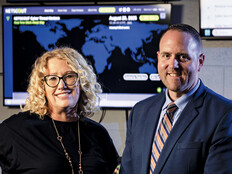How to Delete the Digital Divide
The pandemic laid bare the digital divide, and it is our responsibility to build on the advances we’ve made addressing that gap and give every student more opportunities to thrive. As pandemic emergency funding fades into the rearview mirror, school administrations will have to make thoughtful and intentional technology investments to continue making significant strides toward true digital equity.
In a recent report from the National Bureau of Economic Research, the authors reviewed 31 studies on student spending and noted a strong link between increased spending and improved student outcomes.
Even now, as we are awash in Elementary and Secondary School Emergency Relief (ESSER), Emergency Connectivity Fund and E-rate funding, it is natural to wonder if it makes sense to make long-term plans when some of this money is temporary. I would say yes. President Joe Biden continues to push an ambitious spending proposal through Congress, which comes with a hefty increase in money for K–12. Regardless of the outcome of that bill, we can and should continue to advocate for additional spending in education.
The K–12 learning community has always thrived on partnerships. Teachers know the value of partnering with students, parents, the school board and other parties to achieve their goals. At no time has that been clearer than over these past few years. Properly allocating funds that make the learning environment exciting, stimulating and safe is critical.
Additionally, it helps to turn to experts who can assist schools in navigating funding challenges and make recommendations on the best tools for positive student outcomes and how to use them. Your CDW•G account managers, many of whom are funding experts, are great resources and can work with you to create a long-term plan for an uncertain future.
Investing in a Secure Learning Environment
Another sobering challenge we face today that will impact tomorrow is an increase in cybersecurity breaches. According to security company Emsisoft, ransomware incidents hit 1,043 schools, colleges and universities in 2021 alone. Cyber breaches are devastating. It is important to teach our students to be responsible digital citizens and to create a trusted learning environment for them.
We know that student data privacy is critical. When we commit to keeping our school platforms secure, it is important that we do more than talk and take concrete steps to shore up the network.
MORE ON EDTECH: Schools share strong measures that protect student data.
One of the best ways schools can lock down their networks is by getting an annual checkup. Just like the human body, school organizations are complex systems with multiple opportunities for devastating viruses to grow if left unchecked.
An annual checkup can catch concerning issues in the making, as can regular security assessments. In a recent roundtable discussion with IT leaders from around the country, all agreed that a sound cybersecurity strategy involves vigilance.
It’s good to get in the habit of regular assessments, as they save you money in the long run. Again, this is where partnering with security experts such as those at CDW•G can help school leaders take a more global view of their systems and plan for a secure learning environment now and in the future, which will pay dividends in the long run.
While the past two years have been incredibly challenging, the insights we have gained and the solutions we have implemented have propelled us collectively forward toward a brighter future. Let’s take advantage of the partnerships we’ve built to continue the journey.
This article is part of the “ConnectIT: Bridging the Gap Between Education and Technology” series. Please join the discussion on Twitter by using the #ConnectIT hashtag.







![[title]Connect IT: Bridging the Gap Between Education and Technology](http://www.edtechmagazine.com/k12/sites/default/files/articles/2014/05/connectit.jpg)




